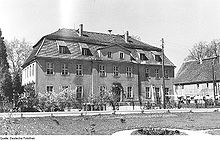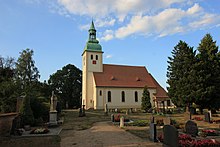Daubitz
|
Daubitz
Dubc Community Rietschen
Coordinates: 51 ° 23 ′ 50 " N , 14 ° 49 ′ 50" E
|
|
|---|---|
| Height : | 143 m above sea level NHN |
| Area : | 22.49 km² |
| Residents : | 563 (Dec. 31, 2009) |
| Population density : | 25 inhabitants / km² |
| Incorporation : | March 15, 1992 |
| Postal code : | 02956 |
| Area code : | 035772 |
|
Daubitz and surroundings on Peter Schenk's map of Upper Lusatia (1759)
|
|
Daubitz , Upper Sorbian , is a district of the Saxon community Rietschen in the district of Görlitz . The church village is located in the Sorbian settlement area in Upper Lusatia .
geography
Daubitz is located in a boggy forest and pond landscape between Weißwasser and Niesky east of Rietschen in the catchment area of the White Schöps . Although this only touches Niederdorf, it is fed by the Daubitzer Dorfgraben and the Raklitza, which runs north of Daubitz .
The Berlin – Görlitz railway line, with the nearest station in Rietschen, runs west of Daubitz. At a short distance from north to south, federal highway 115 runs west and state road 127 east . By Daubitz leading Wolf bike path , a bike path , which the Spreeradweg in Boxberg with the Oder-Neisse Cycle in Steinbach connects. The long-distance hiking trail Ostsee-Saaletalsperren ( Ziegenrück - Barth ) also runs through Daubitz as part of the European long-distance hiking trail E10 .
In addition to the actual village, Daubitz also includes the Neu-Daubitz settlement , the Heidehäuser and Walddorf groups of houses, as well as the Feldhäuser scattered settlement . Neighboring places are Rietschen and Neuhammer in the west, Teicha in the southwest and Quolsdorf (municipality of Hähnichen ) in the south. In the east, an extensive pond area separates Daubitz from the Rothenburg suburbs Neusorge , Lodenau , Ungunst and Steinbach . In the north, the Upper Lusatia military training area joins, in whose territory Tränke was located.
history
The entry in the Meißner diocese register from 1346 indicates that Daubitz was first mentioned. There is an “Altare in Taup” in the Praepositura Budissinensis (Propstei Bautzen). An entry in the oldest Görlitz town register follows in 1366 (beginning in 1305). Daubitz was mentioned under the name Ducz in 1398. It is a street green village that was originally created by the Sorbs and redesigned and expanded by German settlers in the 12th and 13th centuries. Around this time, a manor with a castle and mill was built at the western end of Daubitz , which changed hands more frequently in the following centuries.
A school existed in Daubitz relatively early on. It is documented for the year 1589, which is about two centuries before the founding of schools in most of the surrounding towns and the north-facing state rule of Muskau . Their catchment area extended over the entire parish.
In 1766 it rained so heavily and persistently at harvest time that the rivers and ponds swelled and overflowed, ultimately flooding the village. The flood lasted two days before it sank again.
The Daubitz church, which was mentioned in a document in 1409, was replaced in 1651 by a timber frame church, which received a tower in 1714. Sorbian and German services were held in it until 1858, after which the preaching was only in German. The predominantly western Sorbian villages of Altliebel , Berg, Mocholz , Nappatsch and Viereichen with Zweibrücken then switched to the Reichwalder parish, where Sorbian church services continued to be held. The mainly German villages of Neuhammer , Rietschen , Teicha , Nieder Prauske , Werda , Walddorf and Tränke remained in the Daubitz parish . The dilapidated church was closed in 1911 and replaced by today's stone church between 1914 and 1916. Their interior was taken over. The Wroclaw painter and restorer Joseph Langer took on the artistic design of the church . At the same time a daughter church was built in Rietschen. In 1931 a separate Protestant parish was established in Rietschen, which was still connected to Daubitz through the parish. In the Daubitz parish only the villages of Neuhammer Teicha, Walddorf and the village of Tränke, which was cleared in 1962, remained.
As a result of the Congress of Vienna in 1815 , the Kingdom of Saxony had to cede extensive parts of the country, including the greater part of Upper Lusatia , to the Kingdom of Prussia . After an administrative reform, the Silesian district of Rothenburg (Ob. Laus.) Was established in 1816 , to which the Daubitz parish was incorporated. After the Second World War, the part of Upper Lusatia west of the Lausitz Neisse was connected to the state of Saxony. As part of the administrative reform of 1952 , Daubitz was assigned to the Weißwasser district.
On March 15, 1992 the municipalities of Daubitz, Rietschen, Teicha and Viereichen merged to form the current municipality of Rietschen.
Population development
| year | Residents |
|---|---|
| 1825 | 788 |
| 1871 | 1142 |
| 1885 | 1089 |
| 1905 | 1020 |
| 1910 | 1081 |
| 1925 | 1094 |
| 1939 | 988 |
| 1946 | 1304 |
| 1950 | 1298 |
| 1960 | 1107 |
| 1964 | 981 |
| 1970 | 959 |
| 1980 | 867 |
| 1985 | 787 |
| 1990 | 707 |
| 1996 | 631 |
| 2005 | 621 |
| 2008 | 550 |
| 2009 | 563 |
Daubitz already had a comparatively large number of inhabitants. This is likely to be due to its function as a church village as well as the considerable area of over 2000 hectares. From the year 1777 13 possessed men , 19 gardeners and 50 cottagers have come down to us.
From 1825 to 1871 the population increased by about half from 788 to 1142. In the period that followed, this number fell by around 15% to 988 before the Second World War. Due to refugees and displaced persons from the former eastern German territories, the population rose to over 1,300 after the war, but could not be maintained in the following years. In 1964 it was back below 1000 and in 1990 it was only 700. Almost two decades later, the number was 550.
Daubitz was already in the second half of the 19th century on the outer eastern edge of the Sorbian language area. According to statistics from Arnošt Muka , only 20 Sorbs lived here in 1885 out of a total of 1117 inhabitants.
Place name
The German name Daubitz is derived from the Sorbian name Dubc , which in turn goes back to the Slavic word dub 'oak'. Daubitz is thus, similar to the Hohendubrauer district of Dauban ( Dubo ), a settlement that arose near oaks.
Personalities
Christoph Gabriel Fabricius (1684–1757) had been pastor in Daubitz since 1740. Several church writings come from him in German and Sorbian.
The Daubitz pastor Henner-Jürgen Havenstein (1931–2001) co-founded the New Forum in the Cottbus district in 1989 . In 1996 he received the Order of Merit of the Federal Republic of Germany .
The Daubitzer landowner Friedrich Wilhelm Heinrich von Roeder was the first district of the county Rothenburg (Ob. Laus.) .
Erich Schulze (* 1949) stood at the request of Henner-Jürgen Havenstein as the CDU district administrator for the Weißwasser district . He held this office until the district was dissolved in 1994 and was then district administrator of the Lower Silesian Upper Lusatia district until 2001 .
Culture and sights
- Forest Village Ranch western settlement with bison enclosure in Walddorf
- Kaiser Wilhelm Monument (Monument to German Unity)
- around 450 year old horseshoe elm
- Wolfsstein
Buildings
- Baroque palace , built in 1720
- Manor Park , laid out between 1875 and 1895
- Gewandhaus, built in 1856
- Evangelical St. George's Church, built between 1914 and 1916 in place of the previous church, with frescoes by the Silesian painter Joseph Langer (1865–1918)
Facilities
- Evangelical day care center Daubitz
- Daubitz primary school
- Daubitz School Museum
Regular events
- St. George's Festival in April
- Country festival at the Forest Village Ranch in Daubitz-Walddorf on the last weekend in June
- Thanksgiving service for the Day of German Unity
Sources and further reading
literature
- From the Muskauer Heide to the Rotstein. Home book of the Lower Silesian Upper Lusatia District . Lusatia Verlag, Bautzen 2006, ISBN 978-3-929091-96-0 , p. 251 f .
- Robert Pohl: Heimatbuch des Kreis Rothenburg O.-L. for school and home . Buchdruckerei Emil Hampel, Weißwasser O.-L. 1924, p. 222 f .
- Erich Schulze: Daubitz. Beautiful village on the Weißen Schöps 650 years. Daubitz 2016
Individual evidence
- ^ Daubitz in the Digital Historical Directory of Saxony
- ↑ Ernst Tschernik : The development of the Sorbian population . Akademie-Verlag, Berlin 1954.
- ↑ Ernst Eichler , Hans Walther : Oberlausitz toponymy - studies on the toponymy of the districts of Bautzen, Bischofswerda, Görlitz, Hoyerswerda, Kamenz, Löbau, Niesky, Senftenberg, Weißwasser and Zittau. I name book (= German-Slavic research on naming and settlement history . Volume 28 ). Akademie-Verlag, Berlin 1975, p. 48 f .




